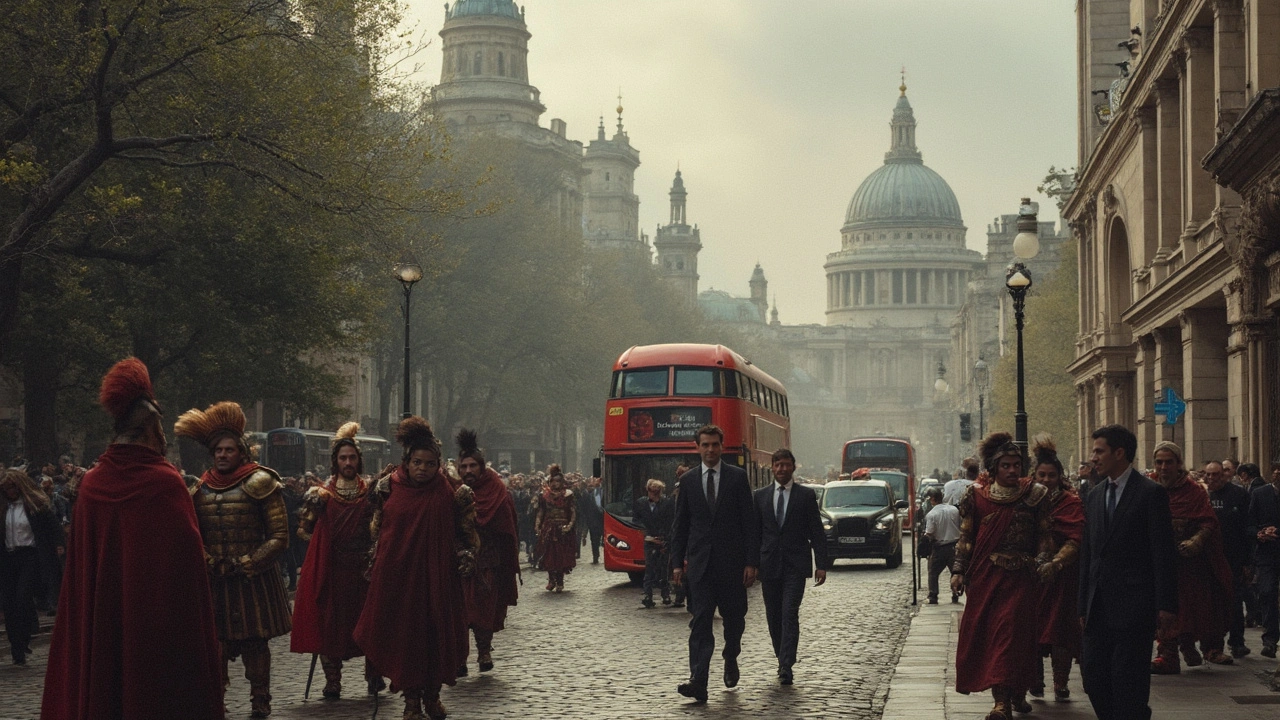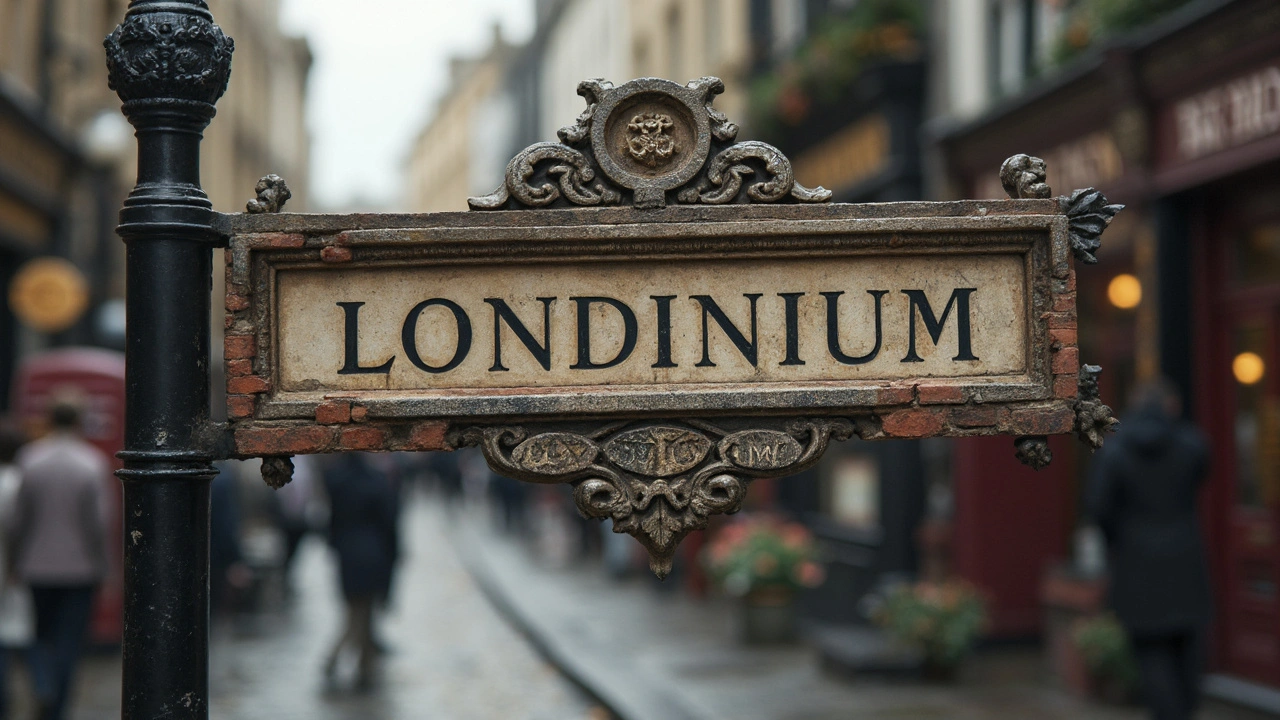
If you think the name 'London' has always been around, you're in for a surprise. Before double-decker buses and black cabs, this city went by a different name: Londinium. That’s right—the Romans were the first to slap that label on the place when they arrived almost 2,000 years ago. But where did Londinium come from? Historians still fuss about the details. Some say it came from an old Celtic word, others swear the Romans just tweaked a local name to sound Latin. Either way, you won’t find any Romans calling it London back then.
This old name isn’t just an odd bit of trivia for historians. Walk around the City of London—the “Square Mile”—and you’re basically tracing the edge of ancient Londinium. Some street layouts even follow the same lines as those Roman roads. Ever wondered why London’s main financial district feels a bit maze-like? Blame the Romans and their quick-building ways. This stuff isn’t hidden away in museums—you can stumble on old walls, bits of Roman mosaic, or even manhole covers proudly stamped with ‘Londinium’ if you know where to look.
- London's First Name: Londinium and Before
- How Londinium Became London
- Hidden Remnants of Ancient London
- Tips for Spotting Old London Names Today
London's First Name: Londinium and Before
Let’s get right to the point: long before selfie sticks by the Thames, the city we call London was known as Londinium. The Romans showed up in AD 43, built a bridge, set up camp, and named their settlement Londinium. It became a big deal fast—by around AD 100, it was the capital of Roman Britain. The city’s location wasn’t random. The Romans picked the spot for easy river crossing, trade, and speed—practical stuff, not just luck.
Londinium wasn’t the first bump in the road here, though. Long before the Romans, Iron Age tribes hung around this patch of land. There’s no solid proof anyone built a real town before the Romans arrived, but bits of pottery and tools pop up from time to time, hinting at action even before Londinium’s official start. If you see claims about “prehistoric London,” take them with a grain of salt—nothing on the scale of Londinium existed.
Historians and language experts argue about the name’s roots. Some claim it comes from ‘Londinios’—maybe meaning “place belonging to a man named Londinos,” but nobody can say for sure. The Romans had a habit of tweaking local words, so Londinium might have been their version of a name already kicking around.
Want some numbers? Here’s how Londinium stacked up during Roman times:
| Fact | Detail |
|---|---|
| Founded | AD 43 |
| Peak Population | 45,000-60,000 |
| Size | 330 acres (the “Square Mile” today) |
| Main Features | A forum, basilica, amphitheatre, and city walls |
If you’re curious about all this, you can still walk the original “Roman Wall” in parts of the city. Sections pop up near Tower Hill and the Barbican, so you don’t even need a ticket to see real pieces of ancient Londinium.
How Londinium Became London
So, how did Londinium turn into the old name for London and lose the extra syllables? Turns out, it wasn’t an overnight switch. The Romans kicked things off with Londinium around AD 43, setting up shop along the River Thames. This name stuck for a few centuries while the Romans ran the show. But by the early 5th century, the Romans pulled out, and the place started to change fast.
After the Romans left, Latin names started to fade because the locals had their own ways of speaking. The Saxons moved in, and you can bet they weren’t saying “Londinium” in their daily chit-chat. Most people reckon the name got shorter as Saxons pronounced it: first Lunden, then Lundenwic (meaning 'London trading town'), and eventually just London as it got easier to say. Writing from the 7th century—like in the Anglo-Saxon Chronicle—uses forms like "Lundenburh" and "Lunden." You can still spot echoes of these names in old records and on old stones tucked away in city corners.
Want to know just how long ago all this went down? Here’s a handy table showing when key name changes happened:
| Time Period | Name Used | Who Used It |
|---|---|---|
| 43 - 410 AD | Londinium | Romans |
| 5th - 7th century | Lunden, Lundenwic | Saxons |
| After 900 AD | London | Everyone (officially) |
The switch from Londinium to London isn’t just about words. Each change matches up with new people moving in, power shifting, and the city itself growing and shifting east, then back to where the Romans first settled. Keep that in mind next time you spot a London street name ending in “-wich” or see “Londinium” carved into anything—it’s all part of the same timeline.

Hidden Remnants of Ancient London
Think modern London swallowed up all traces of its Roman past? Not even close. Bits of old name for London — Londinium — are hiding in plain sight if you know where to look. Head to the Museum of London, and you can actually see a chunk of the Roman wall that used to mark the boundary of Londinium. That same wall runs through car parks and even a few office basements today. It’s the kind of thing you might walk past on your lunch break and never realize you’re inches from something laid down almost two millennia ago.
If you’re into ancient engineering, the Roman amphitheatre under the Guildhall is a proper jaw-dropper. They found it only in the 1980s while laying foundations. Now, you can check out what’s left and see markings on the Guildhall courtyard showing exactly where the old arena once stood. In fact, here are some key Roman sites that are still visible today:
- London Wall: Remnants are visible near the Museum of London and Tower Hill.
- Roman Amphitheatre: Located beneath Guildhall Art Gallery, black stone lines in the courtyard show its outline.
- Billingsgate Roman House and Baths: An ancient bathhouse remains open for tours beneath a modern office.
- Temple of Mithras: You’ll find it off Queen Victoria Street. The temple’s foundation is all that remains, but it’s on public display.
Don’t just take my word for it. According to the Museum of London, archaeological digs have turned up over 400,000 Roman artefacts over the past fifty years. Just check out this handy cheatsheet to where the real bits of Londinium survive:
| Site | Location | What’s Visible |
|---|---|---|
| Roman Wall | Near Museum of London, Tower Hill | Sections of wall, stonework |
| Amphitheatre | Guildhall Yard | Foundations, plaque, courtyard markings |
| Billingsgate Baths | Lower Thames Street | Bathhouse remains |
| Temple of Mithras | Bloomberg Space, Walbrook | Reconstructed temple base |
You wouldn’t guess it grabbing a coffee in the City, but the place is packed with reminders of ancient Londinium. It’s worth slowing down and looking around or taking a quick side trip if you’re in the area. You might just stumble onto the real roots of today’s London—one worn Roman brick at a time.
Tips for Spotting Old London Names Today
Want to catch a glimpse of Roman London? You don't need any special skills—just a bit of know-how and an eye for detail. A lot of street names, place names, and even some hidden signs still carry a bit of that ancient past.
- Ludgate Hill and Bishopsgate didn't just pop up because someone fancied the sound. These spots mark what were once the gates—the big entrances—through the old Roman wall around London (originally Londinium). Check street signs in this area and you’ll often find references to gates, walls, or bars. Even 'Aldgate' means 'old gate.'
- St. Paul's Cathedral stands almost exactly where a Roman temple once sat. Why does that matter? Because old names in this area sometimes have roots even before the church was built—like Watling Street, one of the oldest roads in Britain, carved out by Roman soldiers. You’ll still spot plaques along Watling Street marking its path.
- Museum of London and the Guildhall: Inside and near these places, you can see surviving sections of the ancient London Wall. They’ve got info boards explaining what bits of the wall you’re looking at—handy if you want clear proof of Londinium’s footprint.
- Ever hear of Cornhill or Poultry? Some names are reminders of old markets set up here back in Roman and medieval times. They’re not just there to confuse tourists; they mark areas where locals once gathered to trade hay, poultry, or grain.
Here’s a quick table showing some famous Roman-related names and what they meant:
| Name | Origin | Modern Location |
|---|---|---|
| Ludgate | Roman gate in city wall | Ludgate Hill (near St Paul’s) |
| Aldgate | Means 'old gate' | East edge of the City |
| Bishopsgate | Gate named after bishops’ land nearby | North of Liverpool Street Station |
| Watling Street | Main Roman road from Dover to London | Runs near St Paul’s, into the city |
| Cornhill | Grain market area, roots in Roman trading | Central City of London |
If you’re looking to impress someone or just enjoy urban exploring, grab a map of the Square Mile and look for these names. Next time you walk down Cheapside or Milk Street, remember you’re walking the same ground that Londoners have called home for almost two thousand years.